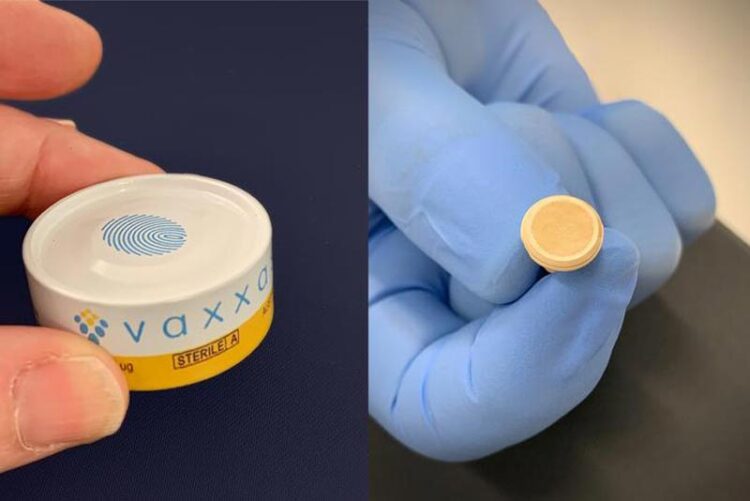A patch of protection against Zika virus

The high-density microarray patch (HD-MAP) up close.
Credit: UQ
A simple-to-apply, needle-free vaccine patch is being developed to protect people from the potentially deadly mosquito-borne Zika virus.
A prototype using The University of Queensland-developed and Vaxxas-commercialised high-density microarray patch (HD-MAP) has delivered a University of Adelaide-developed vaccine and elicited an effective immune response to Zika virus in mice.
UQ alum and Vaxxas researcher Dr Danushka Wijesundara said Zika virus was a risk to people across the Pacific, Southeast Asia, India, Africa and South and Central America.
“We can change the way we combat Zika virus with the HD-MAP patch because it is an effective, pain-free, simple to apply, and easy to store vaccination method,” Dr Wijesundara said.
“HD-MAP delivers the vaccine to immune cells beneath the skin’s surface with thousands of tiny microprojections.
“In our pre-clinical trial, the vaccine provided rapid protection against live Zika virus, targeting a specific protein called NS1 which is crucial to the virus’s survival.
“The vaccine patch evoked T-cell responses that were about 270 per cent higher than from a needle or syringe vaccine delivery.”
Zika virus generally causes a mild illness but infection in pregnancy can lead to miscarriage and stillbirths or infants born with congenital malformations.
In February 2016, the World Health Organization declared a Public Health Emergency of International Concern when Zika virus spread across 40 countries in Latin America, causing more than 1.5 million confirmed or suspected cases in a 6-month period.
The University of Adelaide’s Associate Professor Branka Grubor-Bauk said limited global surveillance shows Zika virus is active in at least 89 countries and territories but there is no currently licensed vaccine.
“This vaccine is unique because it targets a protein inside, rather than outside of the virus meaning it won’t enhance the symptoms of closely related viruses such as dengue fever, in people who’ve been vaccinated,” Dr Grubor-Bauk said.
Dr David Muller from UQ’s School of Chemistry and Molecular Biosciences said the microarray patch and the vaccine could have benefits beyond the ability to protect from Zika virus.
“Because the protein we’re targeting plays a central role in replication in a virus family known as flaviviruses, there’s the potential to apply our approach to target other flaviviruses such as dengue or Japanese encephalitis,” Dr Muller said.
“It could also deliver a vaccine mixture to target the whole family of viruses, providing greater protection.
“A major benefit of the HD-MAP delivery platform is vaccine stability at elevated temperatures – we found the patch retained vaccine potency when stored at 40 degrees Celsius for up to four weeks.
“This increases the reach of vaccines in low- and middle-income countries where refrigeration is challenging.”
The research team would like to acknowledge the National Health and Medical Research Centre (NHMRC) for funding awarded to Dr Muller and The Hospital Research Foundation Group Fellowship awarded to Dr Branka Grubor-Bauk, who supported the project.
The research is published in Molecular Therapy Nucleic Acids.
Journal: Molecular Therapy — Nucleic Acids
DOI: 10.1016/j.omtn.2023.102056
Article Publication Date: 16-Oct-2023
All latest news from the category: Medical Engineering
The development of medical equipment, products and technical procedures is characterized by high research and development costs in a variety of fields related to the study of human medicine.
innovations-report provides informative and stimulating reports and articles on topics ranging from imaging processes, cell and tissue techniques, optical techniques, implants, orthopedic aids, clinical and medical office equipment, dialysis systems and x-ray/radiation monitoring devices to endoscopy, ultrasound, surgical techniques, and dental materials.
Newest articles
Faster, more energy-efficient way to manufacture an industrially important chemical
Zirconium combined with silicon nitride enhances the conversion of propane — present in natural gas — needed to create in-demand plastic, polypropylene. Polypropylene is a common type of plastic found…

Energy planning in Ghana as a role model for the world
Improving the resilience of energy systems in the Global South. What criteria should we use to better plan for resilient energy systems? How do socio-economic, technical and climate change related…

Artificial blood vessels could improve heart bypass outcomes
Artificial blood vessels could improve heart bypass outcomes. 3D-printed blood vessels, which closely mimic the properties of human veins, could transform the treatment of cardiovascular diseases. Strong, flexible, gel-like tubes…





















